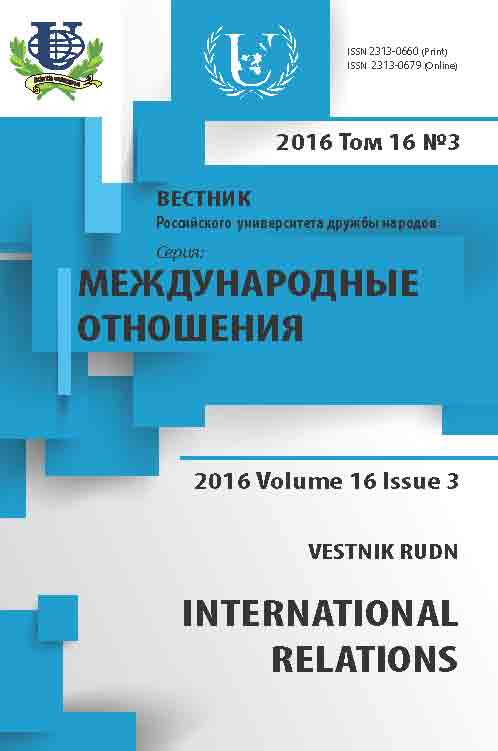Смена приоритетов в стратегиях ведущих доноров международной помощи в 2014-2016 гг.: цели устойчивого развития и фактор безопасности
- Авторы: Максимова А.В.1
-
Учреждения:
- Национальный исследовательский университет - Высшая школа экономики
- Выпуск: Том 16, № 3 (2016): Международные конфликты: Quo Vadis?
- Страницы: 521-537
- Раздел: Статьи
- URL: https://journals.rudn.ru/international-relations/article/view/14769
Цитировать
Полный текст
Аннотация
Статья обращается к вопросу о том, что движет странами-донорами при изменении стратегий содействия международному развитию (СМР). Были проанализированы программные документы девяти доноров, принявших свои стратегии в 2014-2016 гг. В выборку попали в основном традиционные доноры, а также новые европейские доноры Польша и Россия. Для изучения изменений, произошедших в последнее время, стратегии изучались парами: новые, принятые в 2014-2016 гг., документы сравнивались с прежними программными документами. Анализ выявил четыре основных кластера причин или факторов, которые побуждали доноров к пересмотру своих стратегических документов в 2014-2016 гг. или определяли изменение курса данных стратегий: вопросы безопасности, принятие повестки устойчивого развития, экономический и внешнеполитический факторы. В целом, доноры становятся гораздо более открытыми в признании своих целей при оказании помощи развитию. Связка «безопасность-развитие» стала сильнее проявляться почти во всех рассмотренных стратегиях и особенно характерна для Великобритании и Японии. Международная повестка устойчивого развития обусловливает принятие новых стратегий СМР в таких странах, как Германия, Финляндия и Польша. Для ряда доноров, например для Австралии, определяющим оказался экономический фактор. В новой российской стратегии в сфере СМР заметно усиление роли внешнеполитической мотивации при оказании помощи.
Об авторах
Анастасия Викторовна Максимова
Национальный исследовательский университет - Высшая школа экономики
Автор, ответственный за переписку.
Email: nastjamaksimova@gmail.com
Москва, Россия
Список литературы
- Бартенев В.И. Связка «безопасность-развитие» в современных западных исследованиях: от деконструкции к концептуализации // Международные процессы. 2015. № 3. C. 78-97
- Дегтерев Д.А. Содействие международному развитию как инструмент продвижения внешнеполитических и внешнеэкономических интересов // Вестник МГИМО-Университета. 2012. № 2. С. 47-58
- Кокошин А.А., Бартенев В.И. Проблемы взаимозависимости безопасности и развития в стратегическом планировании в Российской Федерации: от целеполагания к прогнозированию // Проблемы прогнозирования. 2015. № 6. C. 6-17
- Максимова А.В. Что ценим, то и оцениваем: оценка результативности содействия международному развитию // Вестник международных организаций: образование, наука, новая экономика. 2015. № 1. C. 56-79
- Bizzarri R. The new Japanese Development Cooperation Charter and the South China Sea disputes. 2016. URL: http://dspace.unive.it/bitstream/handle/10579/8192/988060-1195064.pdf? sequence=2 (accessed 07.07.2016)
- Buzan B., Waever O. Macrosecuritisation and Security Constellations: Reconsidering Scale in Securitisation Theory // Review of International Studies. 2009. 35 (2). P. 253-276
- Corbett J., Dinnen S. Examining Recent Shifts in Australia's Foreign Aid Policy: New Paradigm or More Incremental Change? // Australian Journal of International Affairs. 2016. 70 (1). P. 87-103
- de Renzio P. Seifert J. South-South Cooperation and the Future of Development Assistance: Mapping Actors and Options // Third World Quarterly. 2014. 35 (10). P. 1860-1875
- Dreher A., Nunnenkamp P., Schmaljohann M. The Allocation of German Aid: Self-interest and Government Ideology // Economics & Politics. 2015. 27 (1). P. 160-184
- Gray P.A. Russia as a Recruited Development Donor // The European Journal of Development Research. 2015. 27 (2). P. 273-288
- Gulrajani N. Dilemmas in Donor Design: Organisational Reform and the Future of Foreign Aid Agencies // Public Administration & Development. 2015. 35 (2). P. 152-164
- Kitaoka Sh. Sustainable Development Goals and Japan's Official Development Assistance Policy: Human Security, National Interest, and a More Proactive Contribution to Peace // Asia-Pacific Review. 2016. 23 (1). P. 32-41
- Larionova M.V., Rakhmangulov M.R., Berenson M.P. The Russian Federation’s International Development Assistance Programme: A State of the Debate Report. Institute of Development Studies (IDS). Series “Rising Powers in International Development”. 2014. No. 88
- Phillips L., Jorgensen M. Discourse Analysis as Theory and Method. SAGE Publications, 2002
- Sachs J. Achieving the Sustainable Development Goals // Journal Of International Business Ethics. 2015. 8(2). P. 53-62
- Vernon Ph. What’s not to like about the UK’s new Aid Strategy? 2015. URL: http://www.international-alert.org/blog/whats-not-about-uks-new-aid-strategy#sthash.miHTX5St. Z7cWu6qr.dpbs (accessed 07.07.2016)
- Ware H. Cosmopolitanism, National Interest, Selfishness and Australian Aid // Social Alternatives. 2015. 34 (1). P. 51-57
- Weldes J. Constructing National Interests // European Journal of International Relations. 1996. 3 (2). P. 275-318











